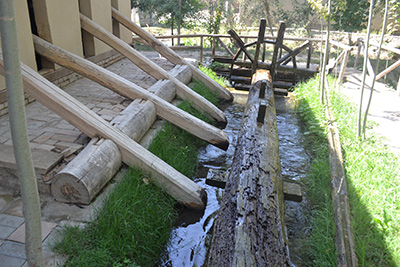
The Road to Samarkand has a much greater meaning to the road that we are travelling along. The Great Silk Road from Central China to Europe had its crossroads in Samarkand and Bukhara and now we are retracing part of that road albeit on a completely different type of surface. Mind you, in some places the road feels like it is the original road.
We pass acre upon acre of cotton fields. Dubbed ‘white gold’, Uzbekistan is the second largest exporter of cotton. Yet, in these fields lies the cause of an environmental disaster. Decades of Soviet irrigation schemes has led to a drastic shortage of water as has been evidenced by the complete collapse of the Aral Sea Basin. So much water has been taken out of the natural system that what is left is heavily polluted and the health of the soil is now very low. This legacy is a real challenge for the Uzbek authorities if they are to continue to reap the benefits from these little balls of white fluff.
To the untrained eye, the cotton crop seems to be quite healthy and what is apparent, as we pass by in our air-conditioned bus, is just how many people are involved in the back breaking task of picking the stuff. This is obviously the place where the university students are being drafted in to help reap the crop for onward production. Apparently, many of these students are not volunteers. Tatiana tells us that in many instances, unless they go out into the fields to pick cotton, they will be kicked out of university by the authorities. In other words, no cotton picking, no degree.
For us, the heat would be intolerable, but there seem to be armies of people out there in the midday sun, toiling away. I take my hat off to them, literally! Along the roadside next to these fields are rows of mulberry trees. Whilst the industrial silk production process is very secretive, there is a small local silkworm production industry and many farmers will grow the trees on their land and reap the leaves to feed the worms who will produce the gossamer-thin threads of silk.
I ask Tatiana what happens to the rest of the trees once the leaves have been stripped. Laura pipes up and asks if I am psychic because in about one hour, she is planning to stop for lunch at a small family business that uses the wood from the mulberry tree to make silk paper.
It is noticeable that we are beginning to leave the flat, arid desert as hills and mountains begin to appear in the distance and it is in the foothills that we pull into an oasis-like compound with lots of trees – and shade! Next to a fast running stream is a small barn and outside is an extraordinary looking waterwheel which appears to power a huge smooth tree trunk that has strategically placed struts sticking out at the side. Apparently all will become clear when we go inside. For now, it was just bliss being able to wander around in the shade of the trees all around us.
Through Tatiana we are introduced to an elderly gentleman who is the owner and who is sitting around a low table next to two ladies. They are stripping the bark off the wood and putting this to one side in a big basket. Inside the barn, there are four clay bowls into which there is a nodding-donkey-like contraption which extends out through an aperture in the wall and down to the long tree trunk outside.

Silk Paper Mill
The elderly gentleman gives a shout and the sluice gate opens to let water into the gulley and the waterwheel slowly begins to turn. This in turn rotates the tree trunk and the strategically placed protrusions strike the end of the nodding-donkey and inside the barn the stripped bark is pulverised into a pulp – very much like how I would use a pestle and mortar in the kitchen.
This pulp is then poured into a press and the end product is a piece of wet paper which is then hung up to dry. This is raw silk paper and before the dried product is ready for the printing process, it is rubbed smooth with a very smooth object, such as a pebble or even a large sea shell. This creates a shiny surface onto which printing ink can be used.
What a fascinating process. Seeing the bark of the tree being turned into a small piece of silk paper using age-old technology was a real privilege. At some time this would all have been done by hand and here is an example of the spread of inventions from our own Industrial Revolution to mechanise a very straightforward process. This is obviously a very small cottage business here but this gentleman had the foresight to open his business to visitors and we have all bought a little memento of our visit. By adding a small café to the side of his home, he has got himself a thriving little business.
Back on the road to Samarkand, we pass through a number of small towns and on the approaches to these towns I notice a steady stream of schoolchildren, all very smartly dressed who at this time of day must be walking home after lessons. Some appear to have to walk tremendous distances to get to and from school. The boys are wearing grey trousers and blazers with white shirts and ties. The girls are wearing navy blue skirts and jumpers topped off with a little white floral decoration in their hair. I am very impressed and think that some of our schoolchildren could learn a lesson or two on appearance from these children. They all seem very happy too and give the bus a big wave as we pass by.